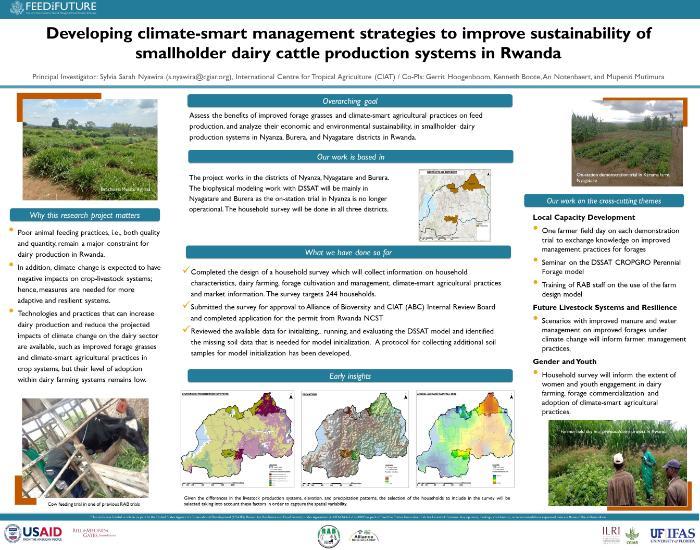Developing Climate-Smart Management Strategies to Improve Sustainability of Smallholder Dairy Cattle Production Systems in Rwanda
- Research Project Location: Rwanda
- Timeframe: August 2023 - September 2024 (Terminated in February 2025)
- Funding: USAID
Introduction
The dairy sector in Rwanda has low productivity and faces future challenges in adapting to climate change. Approaches that quantify the economic and environmental impacts of introducing improved forages alongside climate-smart agricultural practices can help dairy farmers, extension agents, and policy stakeholders adopt new practices to overcome these challenges.
The overall project goal was to assess the benefits of improved forage grasses and climate-smart agricultural practices on feed production and analyze their economic and environmental sustainability in smallholder dairy production systems in Nyanza, Burera, and Nyagatare districts in Rwanda.
Project Objectives
- Characterize, for a range of typical dairy farming systems in Rwanda, the common feed types and associated management practices through a combination of primary and secondary data collection and stakeholder input.
- Improve model assessments of improved forages and maize stover production systems under climate-smart agricultural practices through testing and evaluation of the Decision Support System for Agrotechnology Transfer (DSSAT) CROPGRO perennial forage and CERES maize models.
- Identify CSA practices for improving dairy cattle production and nutrition through combining model simulations and on-farm field assessments, and assess their impacts on GHG emissions, dairy production costs, and income generation.
- Develop guidelines for increasing the adoption of improved forages and climate-smart agricultural practices and disseminate them to key stakeholders.
Approach
A participatory approach was used to characterize the dairy farmer typologies and identify the forages and maize stover production systems, using both survey data from farmers and discussions with stakeholders in the three districts. The Decision Support System Transfer (DSSAT) perennial forage and maize models will be calibrated and evaluated using biomass and soil organic carbon data collected from on-station demonstration plots in the three districts. The evaluated models will be run under different improved management practices, including fertilizer and manure application, residue returns, and varying cutting and harvest frequencies, considering present and future climates. The potential of the improved management practices in increasing livestock feed production will be quantified by comparing the simulated biomass production against the business-as-usual, representing typical management on farms. The biomass data from the different scenarios, together with socio-economic data from the survey, will be applied in running the FarmDESIGN bioeconomic model to assess the economic benefits and trade-offs associated with the adoption of the improved technologies in the different farm typologies. Results from this work will allow us to make recommendations on practical management interventions in the smallholder dairy system that can improve production and farmer livelihoods while increasing the sector’s resilience to climate change.
Principal Investigator (PI) and Lead Institution
Sylvia Sarah Nyawira, International Center for Tropical Agriculture (CIAT)
Co-PIs and Collaborator Institutions
Mupenzi Mutimura, Rwanda Agriculture and Animal Resources Development Board
Ken Boote, UF
Gerrit Hoogenboom, UF
Resources







